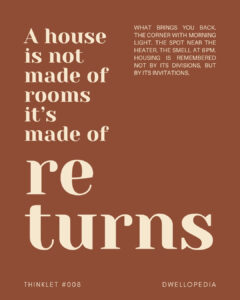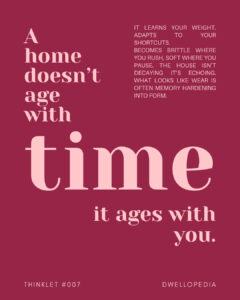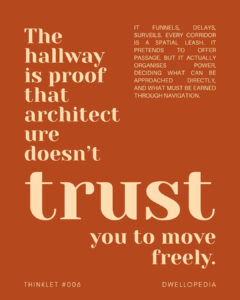We often imagine a home as a flawless refuge, a sanctuary where every corner, every surface, holds the promise of comfort and security. Yet, the truth of dwelling lies not in perfection but in imperfection—those moments when the walls leak their secrets, the rooms resist warmth, and the very plans that promised completeness reveal their cracks. No home is truly yours until it has disappointed you. This statement holds a deep architectural and existential tension, inviting us to reconsider what it means to belong, to inhabit, and to live intimately within a space.
Is it in these moments of failure that architecture speaks most honestly to us? The window that lets in the rain becomes an unexpected companion, drawing our attention to sound, rhythm, and presence. The chilly room teaches patience, adaptation, and the subtle geography of comfort. These architectural “failures” are not flaws to be erased but points of entry into deeper intimacy. They dismantle the illusion of perfection and invite us to live inside the gaps, not merely above or beyond them.
What does it mean for architecture to resist our desires, to challenge our expectations? How does disappointment shape our relationship with space, with home, with the self? These questions unfurl softly, weaving through the folds of our experience as dwellers and makers of space. Here, within the imperfections, lies a profound invitation: to embrace a home as a partner in life’s unpredictability, not a backdrop to it.
Housing Unfolded: Transforming the Practice
How might this thought—that no home is truly yours until it has disappointed you—reshape the very practice of housing design? Traditionally, architecture aspires toward control: seamless finishes, perfectly calibrated systems, and flawless forms that promise comfort and permanence. Yet, to center design on perfection risks creating sterile environments that, while visually appealing, lack the raw texture of life.
Imagine housing design that welcomes its own “failures” as moments of encounter, learning, and intimacy. The leaking window, for example, might no longer be a defect to seal but a deliberate threshold of sensory experience. The sound of rain tapping against glass becomes a lullaby, a reminder of nature’s persistence within the built environment. How might materials be chosen or manipulated to invite such moments, to turn disruption into delight?
Spatially, we might reconsider how rooms that never fully warm shape habitation patterns. These spaces teach us where to gather, where to retreat, and how to negotiate comfort on human terms rather than mechanical ideals. What if architects designed homes to include pockets of challenge—zones that resist but also nurture adaptation? How does this invite a more dynamic and lived-in understanding of space, one where occupants are active participants, co-authors of their environment?
This thought also compels us to reconsider the cultural and social dimensions of housing. Disappointment in the home can be a shared experience, a language that connects residents across time and circumstance. It opens space for empathy, revealing that no dwelling is a perfect fortress but a vessel of human resilience and vulnerability. How might community design incorporate these truths, fostering neighborhoods that embrace imperfection as part of belonging?
Moreover, acknowledging architectural “failures” can ripple through design thinking, encouraging openness to iterative processes, responsiveness to inhabitant feedback, and humility before complexity. This challenges the modernist quest for universality and control, inviting instead an architecture that listens, learns, and evolves. What role do architects play when the goal is not flawless enclosure but ongoing dialogue with unpredictability?
In this transformation, the very language of housing design shifts—from product to process, from object to experience. Intimacy emerges not from idealized spaces but from those that reveal their edges, their limits, and in doing so, invite our presence more fully. Such housing design celebrates the messy, imperfect, yet profoundly human condition of living.
Beyond Boundaries: Layered Understandings
This thought unfolds further when viewed through multiple philosophical and cultural lenses, each revealing new layers of meaning. Sustainability, for example, invites us to embrace the limits and “failures” of buildings as natural phenomena rather than faults. A leaky window might be an entry point to innovative ventilation strategies, passive climate adaptation, or rethinking material lifecycles. How might disappointment in building performance guide ecological humility and creativity?
From a social equity perspective, disappointment becomes a metaphor for the gap between ideal housing and lived reality, often starkest for marginalized communities. How do housing failures—whether in quality, access, or design—shape experiences of exclusion or resilience? Can architecture acknowledge these disappointments openly, fostering designs that confront rather than conceal systemic inequities?
Memory and identity enrich this discourse. Homes carry the traces of their imperfections—wear patterns, repairs, adaptations—that speak of human stories and passage of time. Disappointment in architecture becomes entwined with narratives of belonging, loss, and continuity. What might it mean to design homes that embrace these temporal layers, honoring lived history over pristine aesthetics?
Technology introduces yet another prism. Smart homes and responsive systems promise seamless comfort, yet might also smooth over the unpredictability that invites intimacy. Does technology risk erasing architectural “failures” that connect us to place and self? Or can it be harnessed to deepen our engagement with the subtle rhythms and disruptions of home?
Each perspective refracts the thought differently, challenging architects to embrace complexity rather than singular solutions. The home’s disappointments become not obstacles but invitations to layered understanding, weaving together ecology, culture, identity, and innovation. How might such multifaceted thinking reshape architectural theory and practice, enriching the concept of dwelling itself?
Conclusion
To say no home is truly yours until it has disappointed you is to embrace the poetic complexity of dwelling as a lived, imperfect act. This thinklet plants a seed for architects and thinkers to cultivate spaces that resist perfection, celebrate vulnerability, and invite ongoing conversation between inhabitant and architecture.
In these moments of failure—the leaking window, the cold room—architecture reveals its deepest gift: the capacity to teach, to provoke, and to connect. The home becomes a partner in life’s unfolding narrative, not a static stage.
As you carry this thought forward, ask yourself: How might you design for intimacy that arises not despite but because of disappointment? What spaces in your work invite adaptation, reflection, and resilience? Can you embrace architecture as a living dialogue, where the gaps and fractures become portals to belonging?
The power of this thinklet lies in its refusal to provide certainty. Instead, it offers a space to wonder—how might your next home disappoint you, and in doing so, become truly yours?







